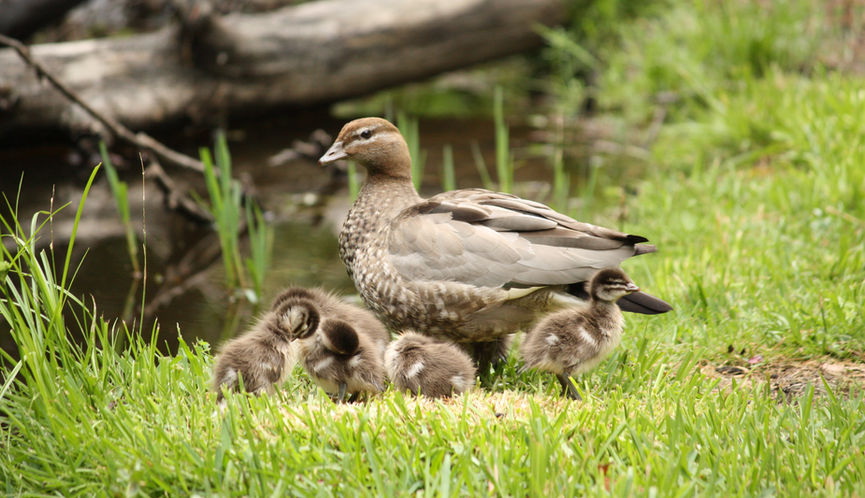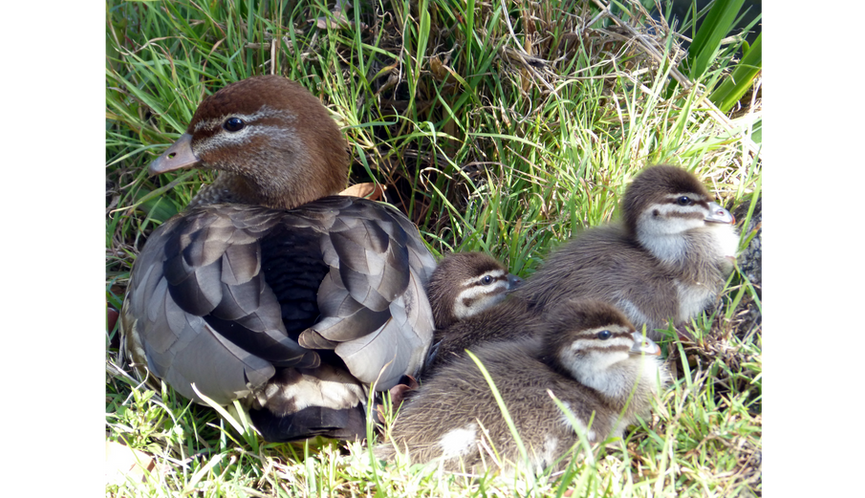Australian Wood Duck
Chenonetta jubata
Quick facts
Other names: Maned Duck, Maned Goose.
Size: Almost as large as a Crow, but much heavier.
Range and lifestyle: Over most of Australia except desert regions. Resident, except during droughts.
Food: Grass, clover, seeds, grain and insects.
Breeding: January to March. Nest in hole in tree, often near water, and cavity lined with down.
Clutch is 8-14 eggs, incubated by mum for about one month. After hatching, the downy ducklings
jump from the hollow to the ground, then follow their parents.
While many of Australia’s 20 native species of waterfowl regularly inhabit artificial lakes and ponds within the urban environment, only one is normally found out of water. The Australian Wood Duck spends little time in the water, feeding mostly on grass rather than aquatic plant seeds and animals.In their grazing behaviour, vegetarian diet and short bill Wood Ducks resemble geese, of which Australia has only two species. While its name “Wood Duck” probably derives from its habit of nesting and perching in trees away from water, it is not unique in this respect as most Australian ducks nest in dead trees and stumps. The qualifier “Australian” is necessary to distinguish it from the Wood Duck of North America. Its alternative name of Maned Duck refers to the short black “mane” of elongated plumes that hang down the hindneck of the male.
Before European settlement, Australian Wood Ducks were probably in woodland and grassland close to wetlands. Since then, the clearing of forest and the creation of pastures and dams for livestock have provided new feeding and resting areas for these birds. They have increased in abundance and distribution since the mid-20th century, and are now quite common in many cities,where they have become quite tame. But rather than becoming adapted to the urban environment,this species seems to have been pre-adapted for living in cities, because urban areas contain a super-abundance of their main natural food – short grass and herbs – among the many lawns in parks,gardens and sports fields. Moreover there are no other resident bird species that compete with them for this resource.
Unlike the clutches of most Australian songbirds, the clutch of the Wood Duck is large, with up to 18eggs in a nest. When they hatch, the ducklings are covered in dark grey and white down feathers, and after floating down from their nest in a tree hollow, are able to feed for themselves. Despite this, they are accompanied and guarded by their parents for more than 10 weeks, though they can fly after 8 weeks. During that period, if humans or other potential predators are spotted from afar, the parents will often lead their brood to safety in the middle of the river or lake. But if an intruder approaches their brood too closely, the parents will charge at it, with outstretched neck and gaping bill.
Text © Richard Noske 2018 CC BY-NC-SA















